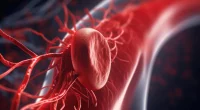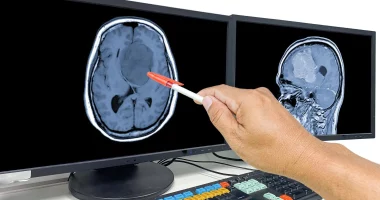Blue Rubber Bleb Nevus Syndrome is an uncommon vascular disorder distinguished by the development of vascular malformations or multiple hemangiomas, throughout the body. These cuts typically appear as rubbery, blue nodules or blebs under the mucous and skin membranes, giving the syndrome its distinctive name. It can affect various organs, including the skin, gastrointestinal tract, and sometimes other organs like the lungs and liver.
The condition may lead to complications like bleeding, iron deficiency anemia, and discomfort depending on the size and location of the lesions. Management often involves treating symptomatic lesions and addressing associated complications to improve the quality of life for affected individuals.
Causes
The exact cause of Blue Rubber Bleb Nevus Syndrome is not well understood, but it is believed to involve genetic changes that affect blood vessel development and formation. BRBNS often appears sporadically, meaning it occurs in individuals without a family history of the condition. However, in some cases, BRBNS has been observed in multiple family members, suggesting a possible genetic predisposition.
The syndrome is thought to arise from abnormalities in the vascular system that cause the formation of hemangiomas, which are clusters of blood vessels that grow abnormally. scientists continue to study the molecular and genetic mechanisms underlying BRBNS to gain a better understanding of its causes and potential treatments.
Symptoms
The symptoms of Blue Rubber Bleb Nevus Syndrome mainly arise from the existence of multiple hemangiomas throughout the body. Frequent symptoms involve:
- Skin Lesions: Blebs or rubbery, bluish nodules on the skin, which are usually painless but can cause discomfort if they grow large or are located in tender areas.
- Gastrointestinal Bleeding: Hemangiomas in the gastrointestinal tract can cause chronic bleeding, resulting in symptoms like black tarry stools, blood in the stool, or anemia.
- Iron Deficiency Anemia: Due to chronic blood loss from gastrointestinal hemangiomas, individuals may develop iron deficiency anemia, which can cause extreme tiredness, weakness, and pale skin.
- Discomfort or Pain: Lesions in various organs can cause discomfort and localized pain, particularly if they press on nerves or other structures.
- Complications in Other Organs: Hemangiomas can also happen in other organs such as the lungs, liver, or central nervous system, potentially leading to complications particular to the affected organ.
The seriousness and range of symptoms can vary widely among individuals with BRBNS, depending on the size, number, and place of the hemangiomas.
Treatment
The treatment of Blue Rubber Bleb Nevus Syndrome aims to manage complications and symptoms linked with the condition. There is no cure for BRBNS, so the main aim is to improve the quality of life for affected people. For skin lesions, treatments may include surgical removal or laser therapy if the lesions are causing significant discomfort or cosmetic concerns. Sclerotherapy, a procedure where a solution is injected directly into the hemangiomas to make them smaller, can also be used. In some cases, medicines like sirolimus, which inhibits the development of blood vessels, may be recommended to decrease the number and size of hemangiomas.
For gastrointestinal bleeding, treatment alternatives include endoscopic procedures to cauterize or rule out bleeding hemangiomas. Iron supplementation or blood transfusions may be necessary to manage anemia resulting from chronic blood loss. In severe cases, surgical resection of affected sections of the gastrointestinal tract might be needed. Additionally, regular checking and follow-up with a healthcare provider are crucial to manage the condition effectively and to address any new or worsening symptoms promptly. Multidisciplinary care involving dermatologists, gastroenterologists, surgeons, and other specialists is often necessary to provide comprehensive care for people with BRBNS.
Diagnosis
The diagnosis of Blue Rubber Bleb Nevus Syndrome typically begins with a thorough clinical examination and detailed patient history. The distinctive bluish, rubbery skin lesions can provide significant clues for diagnosis. Physicians will often perform a physical examination to identify these characteristic hemangiomas on the skin and mucous membranes. In addition to the visual inspection, a detailed medical history, including any instances of gastrointestinal bleeding, anemia, or family history of similar lesions, can aid in the diagnostic process.
To confirm the diagnosis and assess the extent of internal involvement, various imaging studies are employed. Endoscopy is commonly used to visualize and identify hemangiomas within the gastrointestinal tract, which can be a significant source of bleeding. Other imaging techniques, such as magnetic resonance imaging (MRI), computed tomography (CT) scans, and ultrasound, may be utilized to detect hemangiomas in internal organs like the liver, lungs, and central nervous system. In some cases, a biopsy of the skin lesions might be performed to confirm the diagnosis histologically. Accurate diagnosis is crucial for developing an effective management plan and addressing any potential complications associated with BRBNS.
Prevention
Currently, there is no known way to prevent Blue Rubber Bleb Nevus Syndrome because its exact cause is not fully understood, and it often happens sporadically. However, early detection and regular checking can assist manage the condition and prevent complications. This includes:
- Regular Medical Check-ups: Regular visits to healthcare providers to observe for new hemangiomas or modifications in existing ones.
- Timely Treatment: Appropriate treatment of symptomatic hemangiomas to prevent complications like infection and bleeding.
- Managing Symptoms: Addressing symptoms like anemia, pain, and gastrointestinal problems to enhance quality of life.
- Education and Awareness: Educating patients and families about the condition to recognize symptoms early and seek appropriate care.
While prevention of the syndrome itself is not possible, these measures can help mitigate the impact of the condition and improve outcomes for individuals with BRBNS.
Summary
Blue Rubber Bleb Nevus Syndrome is an uncommon disorder characterized by blue, rubbery hemangiomas on the skin and internal organs. Its exact cause is unknown, but it may involve genetic mutations. Symptoms include skin lesions, gastrointestinal bleeding, and anemia. Diagnosis involves physical exams, imaging, and endoscopy. Treatment focuses on managing symptoms, using methods like sclerotherapy, surgery, and iron supplementation. Complications can include chronic bleeding, pain, infection, and organ dysfunction, with no known prevention, but regular monitoring and timely treatment can help manage the condition.









